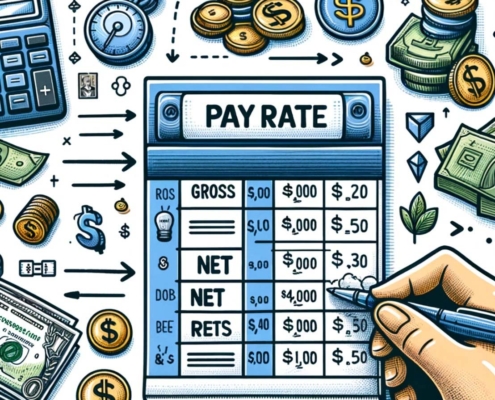9 Box Talent Review: Learn How to Create A 9 Box Grid
The 9 box grid is a HR management tool that managers provide objective, unbiased evaluation of employees who are divided into nine groups, based on their potential and performance.
By Brad Nakase, Attorney
Email | Call (800) 484-4610
What is a 9 box grid?
A 9-box grid, also known as a 9 box talent review grid or a performance-potential grid, is a popular tool used in talent management and human resources. It is mainly used to evaluate and assess employees based on their performance and potential for future growth or advancement within a company.
The 9 box talent review grid consists of a 3×3 matrix, creating nine individual cells or boxes. Typically, one axis of the grid represents an employee’s current performance level, while the other axis represents their potential or future capability. The performance level is often assessed based on criteria like job performance, skills, competencies, and results achieved. The potential axis reflects an employee’s ability to take on more significant responsibilities, develop new skills, or assume leadership roles.
Each employee is then plotted or placed within one of the nine cells of the grid based on their performance and potential ratings. The specific labels or descriptions for each cell can vary depending on the company’s needs, but commonly-used labels include:
- High Performers with High Potential: These employees are considered top talents within the company. They consistently deliver excellent results and have the potential to take on significant leadership roles in the future.
- High Performers with Moderate Potential: These employees excel in their current roles and perform at a high level. However, their potential for growth or advancement may be limited compared to those in the top category.
- High Performers with Low Potential: These employees consistently achieve excellent results in their current positions, but their potential for further growth or advancement within the organization is regarded as limited.
- Moderate Performers with High Potential: These employees show promise and have the potential to take on more significant responsibilities or leadership roles, despite their current performance level being average or moderate.
- Moderate Performers with Moderate Potential: These employees perform adequately in their current roles, but their potential for significant growth or advancement is also considered average or moderate.
- Moderate Performers with Low Potential: These employees have average or moderate performance levels, and their potential for future growth or advancement is limited.
- Low Performers with High Potential: These employees have demonstrated the potential for growth or advancement, despite their current poor performance. They may require additional support, coaching, or development to improve their performance.
- Low Performers with Moderate Potential: These employees have below-average performance, and their potential for growth or advancement may be limited compared to others.
- Low Performers with Low Potential: These employees have poor performance levels, and their potential for future growth or advancement within the company is seen as limited.
The purpose of the 9 box grid is to help companies identify and differentiate talent within their workforce, prioritize development efforts, succession planning, and make informed decisions regarding promotions, transfers, or other talent-related initiatives. The 9 box talent review grid offers a visual representation that can guide discussions and actions related to talent management strategies.
In this article, our attorney for employers discusses the 9 box grid as follows:
What are the advantages of using a 9 box grid?
The use of a 9 box grid offers several advantages in talent management and appraisal processes. Above all, the 9 box grid provides a straightforward and visually intuitive framework for evaluating employees. It simplifies the complex task of assessing performance and potential by categorizing employees into specific cells based on two key dimensions. This simplicity of a 9 box talent review grid makes it easy for managers and HR professionals to understand and use effectively.
The 9 box talent review grid also helps identify high-performing employees with significant potential for growth and advancement. By plotting employees within the grid, organizations can quickly identify their top talents, enabling them to focus their resources and efforts on nurturing and retaining these valuable individuals. This identification can lead to targeted development initiatives and succession planning for key positions.
The use of a 9 box talent review grid also encourages a more holistic evaluation of employees by considering both their current performance and their future potential. It recognizes that performance alone may not be sufficient for long-term success within an organization. By incorporating potential as a key factor, the grid helps identify employees who may not be top performers at present but have the capability to grow and contribute significantly in the future.
A 9 box talent review grid can be adapted to suit various talent management needs and objectives. Organizations can customize the performance and potential criteria based on their specific requirements and industry context. Additionally, the grid can be used at different levels within the organization, from individual employee assessments to evaluating teams, departments, or even the entire workforce. This versatility allows organizations to tailor the grid to align with their talent management strategies and goals.
The visual representation of the 9 box grid facilitates discussions and decision-making processes related to talent management. It provides a common language and framework for managers and HR professionals to discuss employee performance and potential, enabling more objective and informed conversations. The grid can serve as a basis for identifying development needs, creating career plans, making promotion decisions, and allocating resources effectively.
With an eye toward the future, the tool is particularly useful for succession planning initiatives. By assessing an employee’s performance and potential, organizations can identify individuals who are ready or have the potential to take on critical roles in the future. This helps ensure a pipeline of capable and prepared leaders, reducing the risk of talent gaps and enabling smooth transitions during times of change.
Overall, the 9 box grid offers a practical and flexible approach to talent assessment, providing companies with a valuable tool to identify, develop, and make use of their top talent effectively.
How to create a 9 box grid
Step 1: Assessing performance
The first step in creating a 9 box grid involves assessing employee performance. Evaluating performance accurately and fairly is crucial for effective talent management and determining the placement of individuals within the grid. To properly assess an employee’s performance, consider taking the following steps:
- Define Clear Performance Criteria: Start by establishing clear and measurable performance criteria that align with the employee’s role and responsibilities. These criteria can include job-specific objectives, competencies, skills, and behavioral expectations. Well-defined criteria provide a foundation for evaluating performance consistently across employees.
- Gather Performance Data: Collect relevant performance data through various sources. This can include regular performance reviews, self-assessments, feedback from managers, colleagues, and customers, performance metrics, project outcomes, and any other available performance-related information. It’s important to ensure that the data collected is objective, reliable, and comprehensive.
- Use Multiple Assessment Methods: Use a combination of assessment methods to obtain a well-rounded view of an employee’s performance. This may involve a mix of quantitative measures (ex: sales targets, productivity metrics) and qualitative evaluations (ex: manager feedback, peer reviews). Different methods provide different perspectives and help paint a comprehensive picture of an employee’s performance.
- Consider Both Individual and Team Contributions: Assess an employee’s performance both in terms of their individual contributions and their ability to work collaboratively within a team. This helps capture the full extent of their impact and effectiveness in their role. Evaluate how well they collaborate, communicate, and contribute to team goals and dynamics.
- Take Performance Trends into Account: Look for patterns or trends in an employee’s performance over time. Assess whether their performance has consistently improved, remained stable, or declined. Considering performance trends helps identify employees who have consistently excelled or those who may be facing challenges or development needs.
- Incorporate Development Opportunities: While assessing performance, consider opportunities for employee development. Identify areas where an employee has shown improvement or has the potential to grow further. This information can inform discussions about their future potential and guide the creation of individual development plans.
- Conduct Fair and Objective Evaluations: Ensure that the assessment process is fair and unbiased. Provide clear guidelines and training to managers involved in evaluating performance to minimize subjectivity and ensure consistency. Encourage open and honest communication, allowing employees to provide input and share their perspectives on their performance.
Remember that performance assessments should be a continuous process, rather than a one-time event, to capture a more accurate and up-to-date understanding of an employee’s capabilities.
Step 2: Assessing potential
The next step in creating a 9 box grid involves assessing an employee’s potential. Evaluating potential requires considering an individual’s capacity for growth, development, and future success within the organization. Consider the following steps involved in analyzing an employee’s potential:
- Identify Key Factors: Identify the key factors that contribute to an employee’s potential within your organization. This can include attributes such as learning agility, adaptability, leadership skills, problem-solving abilities, strategic thinking, interpersonal skills, and willingness to take on new challenges. Consider the specific competencies and characteristics that are critical for success in your organization and align them with the evaluation of potential.
- Consider Performance and Competencies: Evaluate an employee’s current performance and competencies as indicators of their potential. High performers who consistently go above and beyond and demonstrate a strong skill set in their current role may be more likely to have the potential for growth and advancement. Look for evidence of their ability to take on additional responsibilities or expand their skill set beyond their current role.
- Assess Learning and Development: Consider an employee’s willingness and ability to learn and develop new skills. Look for instances where they have shown a capacity for acquiring new knowledge, seeking out learning opportunities, and applying what they have learned to improve their performance. Assess their openness to feedback and their engagement in developmental activities.
- Evaluate Ambition and Drive: Assess an employee’s ambition and drive to take on more significant challenges and responsibilities. Look for signs of their willingness to go above and beyond their assigned tasks, take initiative, and proactively seek opportunities for growth. Employees who demonstrate a strong desire to advance their careers and contribute to the company’s success often exhibit higher potential.
- Consider Interpersonal and Leadership Skills: Evaluate an employee’s interpersonal skills, collaboration abilities, and leadership potential. Assess their ability to work effectively with others, influence and inspire their colleagues, and handle conflicts or challenging situations. These skills are essential for individuals with the potential to take on leadership roles within the company.
- Seek Multiple Perspectives: Gather input from various sources, including managers, peers, and colleagues who have worked closely with the employee. Their insights and observations can provide a more comprehensive understanding of an employee’s potential. Feedback from mentors, coaches, or previous performance reviews can also offer valuable insights into an employee’s growth and potential.
- Identify Development Needs: While assessing potential, identify specific areas where an employee may need development or support to fulfill their potential. This can inform discussions around targeted development plans, mentoring opportunities, or stretch assignments that can help them grow and maximize their potential.
Remember that assessing potential is not an exact science, and it involves some degree of judgment and subjective evaluation. It is important to be aware of potential biases and strive for objectivity and fairness throughout the assessment process.
Step 3: Plot on the grid
Plotting performance and potential on a 3×3 grid is the final step in creating the 9 box grid. This step involves visually representing employees’ performance and potential ratings within the defined matrix. To correctly plot your data on a grid, follow these steps:
- Establish the Axes: The 3×3 grid consists of two axes: one for performance and the other for potential. Decide which axis will represent each dimension. Usually, the horizontal axis represents performance (ranging from low to high), while the vertical axis represents potential (also ranging from low to high). This arrangement allows for easy categorization of employees based on their ratings within the 9 box talent review grid.
- Determine Rating Labels: Define the rating labels or categories for each axis. These labels can vary based on your organization’s specific criteria and needs. For performance, you might use labels such as “Low,” “Moderate,” and “High.” For potential, labels like “Low,” “Moderate,” and “High” or “Limited,” “Moderate,” and “High” can be used. Ensure that the labels clearly indicate the range of performance and potential for each axis.
- Plotting the Data: Take each employee’s performance and potential ratings and plot them on the grid. Locate the intersection point on the grid that corresponds to the employee’s ratings. For example, if an employee has a high performance rating and high potential rating, they would be placed in the top-right cell of the grid. Similarly, an employee with low performance and low potential would be placed in the bottom-left cell. Plotting the data visually helps provide a clear representation of where each employee stands in terms of their performance and potential within the 9 box talent review grid.
- Interpretation and Analysis: Once employees are plotted on the grid, analyze the distribution of employees across the cells. This analysis provides valuable insights into talent management and decision-making. Identify patterns and trends, such as concentrations of high-potential employees in specific areas of the grid or clusters of low-performing individuals. This analysis helps in identifying talent gaps, focusing development efforts, and making strategic decisions regarding promotions, succession planning, or talent retention strategies.
- Act on Findings: Based on the analysis, take appropriate action for each employee or group of employees. This can involve implementing targeted development plans for employees with high potential, providing additional support or coaching for those with low performance, or considering talent mobility opportunities for individuals in specific cells. The 9 box grid acts as a guide for talent management strategies and helps organizations make informed decisions about their workforce.
Regularly review and update the 9 box grid as employees’ performance and potential change over time. Reassessing and re-plotting employees in the 9 box talent review grid ensures that talent management strategies remain relevant and responsive to evolving company needs.
What is the ‘bad hires’ box?
The “bad hires” box in the lower left corner of a 9 box grid represents employees who have both low performance and low potential. These individuals are typically considered as poor fits for the company and may have a negative impact on organizational effectiveness.
Employees in the “bad hires” box tend to have low performance, meaning they consistently underperform or fail to meet job expectations. Their lack of productivity can hinder team performance, delay projects, and negatively impact overall results. This can lead to decreased efficiency and lower output for the company.
Poorly performing employees can have a negative influence on their colleagues and team morale. Their lack of motivation, commitment, or skills can create a toxic work environment, demotivating others and potentially leading to a decrease in overall employee engagement and job satisfaction.
The presence of “bad hires” can also contribute to higher turnover rates within an organization. Other employees may become frustrated or disillusioned by having to compensate for the poor performance of their colleagues or witnessing a lack of consequences for subpar work. High turnover can be costly for companies due to recruitment, training, and onboarding expenses.
Further, employees in the “bad hires” box may struggle to meet customer expectations or deliver satisfactory service or products. This can lead to poor customer experiences, dissatisfaction, and potentially damage the company’s reputation. Negative customer interactions can result in lost business opportunities and decreased customer loyalty.
In addition to their low performance, individuals in the “bad hires” box may require excessive time and resources to manage and support. Managers and supervisors may need to invest significant effort in training, coaching, and performance improvement plans with limited success. These resources could be better allocated to high-potential employees who are more likely to drive positive outcomes for the company.
Poor performers may also disrupt team dynamics and collaboration. Their lack of skills or motivation may create imbalances in workload distribution, resulting in resentment or frustration among their colleagues. The presence of underperforming employees can hinder effective teamwork, communication, and cooperation within the company.
Addressing the issue of “bad hires” is essential for organizations to maintain a productive and positive work environment. This can involve performance improvement plans, reassignment to more suitable roles, additional training or support, or, in severe cases, considering termination if other interventions prove ineffective.
How to manage ‘bad hires’
Dealing with individuals who fall into the “bad hires” box of a 9 box grid requires careful consideration and appropriate action.
Before taking any action, it is important to understand the reasons behind an employee’s low performance and potential. Conduct a thorough evaluation to identify any underlying issues that may be contributing to their poor fit within the organization. This may involve reviewing their performance records, gathering feedback from colleagues and supervisors, and conducting discussions to understand their challenges and limitations.
Hold open and honest conversations with the employee to provide clear feedback about their performance and potential. Communicate specific areas where they are falling short and discuss the impact of their performance on the team and organization. Use constructive feedback to help them understand the gaps and areas for improvement. Ensure that the feedback is specific, actionable, and focused on behaviors rather than personal attacks. You want this conversation to result in positive change, not a shouting match.
Explore opportunities to support the employee’s growth and development. Provide resources, training, or mentoring to help them improve their skills and performance. Develop a performance improvement plan with clear goals, timelines, and support mechanisms. Offer guidance and coaching to help them address their weaknesses and enhance their capabilities. By investing in their development, you provide an opportunity for improvement and growth.
Clearly communicate performance expectations and the consequences of failing to meet them. Ensure the employee understands the standards they need to meet and the timeframe for improvement. Clearly outline the potential outcomes if their performance does not improve, such as further coaching, reassignment, or, in severe cases, termination. Setting clear expectations helps the employee understand the seriousness of the situation and the need for improvement.
You should continuously monitor the employee’s progress and provide regular feedback along the way. Offer support and guidance as they work toward meeting the performance expectations. Regular check-ins allow for course correction, reinforcement of positive behaviors, and identification of any additional support needed. Consistent feedback helps the employee stay accountable and focused on their improvement efforts.
If the employee’s performance and potential do not show improvement over a reasonable period despite support and interventions, it may be necessary to explore alternative options. This could involve transferring the employee to a role that better aligns with their skills, reassigning them to different responsibilities, or providing opportunities for them to transition out of the organization. In some cases, termination may be the most appropriate course of action if all other efforts have been exhausted and the employee’s performance remains consistently poor.
Throughout the process, maintain thorough documentation of performance discussions, improvement plans, and any steps taken to address the situation. Adhere to company policies and legal requirements to ensure fairness, consistency, and compliance with employment laws. Consult with HR professionals or legal experts as needed to navigate complex or sensitive situations.
It is essential to approach these conversations and actions with empathy, professionalism, and fairness. While the goal is to address poor performance, the focus should be on providing opportunities for improvement, growth, and, if possible, helping the employee transition to a more suitable role within or outside the company.
What is the up-or-out box?
The “up or out” category in a 9 box grid refers to employees who demonstrate high potential but have low current performance. These individuals have the capacity to grow and take on higher-level responsibilities within the organization, but their current performance does not meet expectations.
Employees in the “up or out” category possess the attributes, skills, and qualities that indicate they have the potential to excel and make significant contributions in more challenging roles. They may show ambition, adaptability, a willingness to learn, and strong leadership capabilities, among other key traits.
Despite their potential, employees in the “up or out” category have not yet reached the desired level of performance in their current role. They may be struggling with specific tasks, lacking certain skills, or facing challenges that hinder their ability to perform at a high level. Their current performance may not align with their potential.
Identifying individuals in the “up or out” category presents an opportunity for targeted development. These employees can benefit from focused support, training, and coaching to bridge the gap between their current performance and their potential. Development plans can be created to address specific areas for improvement and help them grow into their potential.
Providing “up or out” employees with stretch assignments or special projects can help them gain valuable experience, develop new skills, and expand their capabilities. These opportunities challenge them to step outside their comfort zone and demonstrate their potential. Assigning them to cross-functional teams or offering exposure to different areas of the organization can also contribute to their growth.
It is important to set clear performance expectations for employees in the “up or out” category. Clearly communicate the standards they need to meet and the timeline for improvement. Regularly monitor their progress and provide constructive feedback along the way. Transparent communication helps them understand the importance of raising their performance to match their potential.
Regular reassessment is necessary to evaluate the progress of employees in the “up or out” category. At specific intervals, review their performance and potential to determine if they have made significant strides in bridging the performance gap. If an employee shows consistent growth and improvement, they may move into a higher-performance category. However, if the performance gap persists despite efforts and opportunities for development, the organization may consider alternative career paths or transitioning them out of the organization.
Establish a supportive culture that values growth, development, and learning. Provide the necessary resources, such as training programs, mentoring, coaching, and feedback mechanisms, to help employees in the “up or out” category realize their potential. Encourage a growth mindset and create an environment where employees feel safe to take risks and learn from their mistakes.
How to manage ‘up or out’ employees
Dealing with individuals who fall into the “up or out” category of a 9 box grid requires a strategic approach that balances their potential with the need for improvement in current performance.
Hold open and honest conversations with employees to discuss their potential and the gap between their current performance and their potential. Clearly communicate the expectations for their role and address any areas where they are falling short. Offer constructive feedback that focuses on specific behaviors and skills that need improvement.
Conduct a comprehensive assessment of the employee’s strengths and areas for improvement. Work closely with them to identify the specific development needs that will help bridge the performance gap. This may involve creating an individual development plan that includes targeted training, mentoring, coaching, or other learning opportunities to enhance their skills and competencies.
Provide opportunities for employees in the “up or out” category to take on challenging assignments or projects that align with their potential. Stretch assignments can help them develop new skills, gain exposure to different areas of the organization, and showcase their capabilities. Assignments that push them beyond their current role can accelerate their growth and help close the performance gap.
You might also assign a mentor or coach who can guide and support the employee’s development journey. A mentor or coach can provide valuable insights, offer guidance on specific skills or knowledge areas, and help the employee navigate challenges. Regular check-ins with the mentor or coach can ensure the employee receives ongoing support and feedback.
Collaborate with the employee to create a structured development plan that outlines clear goals, milestones, and timelines. The plan should focus on developing the specific skills and competencies required to improve their performance and align it with their potential. Regularly review and update the plan based on progress and evolving needs.
Be sure to continuously monitor the employee’s progress and provide timely feedback on their performance and growth. Regularly review their development plan to assess their achievements and identify areas that may need further attention. Offer feedback that reinforces positive behaviors, highlights improvements, and addresses areas for further development.
What are the ‘workhorse’ and ‘dysfunctional genius’ boxes?
The “workhorses” and “dysfunctional geniuses” boxes in the 9 box grid represent two distinct types of employees within an organization. The following is an overview of each category and how best to deal with individuals falling into these boxes:
Workhorses
The “workhorses” category typically includes employees who consistently deliver high performance but may have limited potential for growth or advancement within the organization. They are reliable, dependable, and often excel at their assigned tasks. They contribute to the day-to-day operations and play a crucial role in maintaining the organization’s efficiency.
To best manage workhorses, recognize their value by acknowledging their consistent performance and contributions. Reward their efforts through appropriate recognition programs, bonuses, or career development opportunities that provide job satisfaction and motivation.
Further, encourage workhorses to develop new skills and expand their knowledge base. Offer training programs or cross-functional assignments that broaden their expertise and help them take on additional responsibilities within their current roles.
You should retain workhorses by creating an environment that supports their job satisfaction and engagement. Provide opportunities for them to share ideas, contribute to decision-making processes, and take ownership of projects. Regularly check in with them to address their needs, concerns, and aspirations.
You might also look for ways to enrich their roles and responsibilities to provide variety and challenge. This can help prevent workhorses from becoming complacent or feeling stagnant in their positions. Consider assigning them projects that leverage their skills and knowledge, allowing them to make a broader impact within the organization.
Dysfunctional Geniuses
The “dysfunctional geniuses” category represents employees who possess exceptional skills, knowledge, or talent but may exhibit challenging behaviors or interpersonal difficulties. They often demonstrate high potential, but their disruptive behavior or inability to work well with others can hinder their effectiveness and impact team dynamics.
To manage dysfunctional geniuses, you should first identify and address the specific behaviors that are causing dysfunction within the team or organization. Provide feedback to the employee about the impact of their behavior on others and the work environment. Clearly communicate the expected standards of behavior and the consequences of not improving.
Consider offering coaching and development interventions to help dysfunctional geniuses improve their interpersonal skills, emotional intelligence, and collaboration abilities. Focus on helping them understand the importance of effective teamwork, conflict resolution, and building positive relationships with colleagues.
Be sure to clearly establish boundaries and expectations for behavior within the organization. Reinforce the understanding that exceptional talent alone is not sufficient to warrant tolerance for disruptive or harmful behavior. Emphasize the importance of collaboration, respect, and professionalism as essential components of individual and organizational success.
It is a good idea to implement strategies to facilitate collaboration and teamwork among dysfunctional geniuses. Encourage them to actively listen, seek input from others, and work on building positive relationships. It might also be wise to assign mentors or coaches who can provide guidance and support in improving their collaborative skills.
If dysfunctional geniuses fail to make sustained improvements in their behavior despite support and intervention, it may be necessary to impose consequences. This can include formal disciplinary actions, reassignment to roles that minimize negative impacts, or, in extreme cases, termination if other measures prove ineffective and their behavior continues to disrupt the organization.
It is important to remember that addressing dysfunctional behavior should always be approached with empathy, fairness, and a focus on growth and improvement. Providing support and opportunities for change can help individuals in this category leverage their exceptional talents while also fostering a positive and productive work environment.
What is the ‘future stars’ box?
The “future stars” box in a 9 box grid represents employees who demonstrate both high performance and high potential for growth and advancement within the organization. These individuals possess the skills, capabilities, and qualities necessary to become key contributors and leaders in the future.
You should be sure to acknowledge the potential of future stars by recognizing their achievements, strengths, and growth prospects. Provide positive feedback and encouragement to reinforce their exceptional performance and potential. You should make it clear that the company is devoted to nurturing their development and career advancement.
You might also offer targeted development opportunities to help future stars fulfill their potential. Identify their specific growth areas and create tailored development plans that focus on enhancing their skills, knowledge, and leadership abilities. Provide access to training programs, mentoring relationships, cross-functional projects, and stretch assignments that challenge and expand their capabilities.
It may be a good idea to assign experienced mentors or coaches who can guide and support the development of future stars. These mentors can provide valuable insights, share their experiences, and offer advice on career advancement. Regular coaching sessions can help individuals navigate challenges, set goals, and chart a path for their professional growth.
When it comes to thinking about the future of the company, incorporate future stars into the organization’s succession planning process. Identify key roles or positions that align with their career aspirations and potential. Consider grooming them for future leadership positions by providing exposure to different aspects of the business, cross-functional collaborations, and opportunities to lead high-impact projects.
You should encourage future stars to actively engage in collaboration and networking within and outside the organization. Provide opportunities for them to build relationships with senior leaders, industry professionals, and peers. Encouraging participation in professional associations, industry events, and community initiatives can broaden their exposure and expand their network.
It is important to continuously review the career progress of future stars and identify advancement opportunities. Plan for their potential promotion or reassignment to higher-level positions as they develop and demonstrate readiness. Be sure to engage in open and transparent conversations about their career aspirations, aligning them with the organization’s goals.
Future stars should be assured of their importance to the company. As a manager or HR professional, you can implement retention strategies to ensure their long-term commitment to the organization. This might include offering competitive compensation and benefits, creating a positive work culture, providing opportunities for autonomy and growth, and fostering a sense of purpose and fulfillment.
What is the ‘stars’ box?
In the context of a 9 box grid, the “stars” box typically refers to the quadrant that contains employees who exhibit both high performance and high potential. These individuals are considered top talent within the organization and have the ability to make a significant impact on its success. Managing employees in the “stars” box requires a strategic and proactive approach.
You should recognize the achievements and contributions of the “stars” by providing regular feedback, acknowledging their accomplishments, and offering appropriate rewards and incentives. This recognition helps motivate and retain top talent, reinforcing their value to the organization.
Providing meaningful career development opportunities for “stars” can further enhance their skills and competencies. You might offer challenging assignments, stretch projects, and opportunities for growth and advancement within the organization. Create a clear career path and development plan that aligns with their aspirations and potential.
It is also a good idea to pair “stars” with experienced mentors or coaches who can provide guidance, support, and insights. Mentoring and coaching relationships help accelerate their development, provide valuable feedback, and expand their professional networks.
Be sure to give “stars” high-visibility projects or leadership roles that allow them to demonstrate their capabilities and have a broader impact on the organization. These assignments provide opportunities for growth, showcase their talent to senior leaders, and help build their reputation within the company.
Similar to future stars, you should encourage “stars” to build relationships and network with influential stakeholders within and outside the organization. Facilitate their participation in industry events, conferences, and professional associations to broaden their perspectives and enhance their visibility in the industry.
“Stars” are prime candidates for succession planning and leadership development initiatives. Identify key leadership positions within the organization and consider “stars” as potential successors. It is critical to invest in their development to prepare them for future leadership roles, including executive training programs, leadership assessments, and grooming them for higher-level responsibilities.
You should recognize that “stars” are in high demand and may receive job offers from other interested companies. Therefore, it is important to implement effective retention strategies, such as competitive compensation packages, flexible work arrangements, opportunities for advancement, a positive work culture, and ongoing career development to keep them engaged and committed to the company.
Continuously monitor the performance of “stars” and provide regular feedback and coaching. Set challenging goals, provide opportunities for them to showcase their capabilities, and align their objectives with the strategic goals of the organization. Regular performance discussions help maintain alignment, address any performance issues promptly, and provide growth opportunities.
Remember that managing “stars” requires a balance between challenging and supporting them. Providing a nurturing environment that fosters their growth, recognizes their contributions, and aligns their aspirations with organizational goals is crucial to retaining and maximizing the potential of these top performers.
Can a 9 box grid help with succession planning?
A 9 box grid can be a valuable tool in succession planning as it helps identify high-potential employees and assess their readiness for key leadership positions. This tool enables companies to identify employees who exhibit both high performance and high potential. These individuals, usually located in the “future stars” category, are the perfect candidates for succession planning. Their placement in the grid indicates their readiness to take on more significant responsibilities and leadership roles.
The 9 box grid provides a visual representation of an organization’s leadership bench strength. By plotting current leaders and potential successors on the grid, it becomes easier to identify gaps and areas of strength. This assessment helps organizations understand the depth and breadth of talent available for succession planning purposes.
The 9 box talent review grid also helps focus development efforts on individuals in specific categories. High-potential employees falling in the “up or out” category may require targeted development interventions to bridge performance gaps and prepare them for future leadership roles. Meanwhile, those in the “workhorses” category may benefit from skill enhancement initiatives to expand their capabilities.
The 9 box talent review gridalso serves as a starting point for identifying potential successors for critical leadership positions. Individuals in the “future stars” category who demonstrate both high performance and high potential are strong candidates for succession planning initiatives. They can be further assessed through competency evaluations, performance reviews, and assessments to determine their suitability for specific leadership roles.
With the help of a 9 box grid, an employer may tailor individual development plans for potential successors. Based on the position’s requirements and the identified gaps in knowledge, skills, and competencies, targeted development initiatives can be designed to prepare potential successors for their future roles. This may include job rotations, mentoring, coaching, formal training programs, or exposure to senior leaders.
Another benefit of a 9 box talent review grid is that organizations can monitor the progress and readiness of potential successors over time. Regular assessments and feedback help track their development, identify areas of improvement, and make necessary adjustments to development plans. This ongoing evaluation ensures that potential successors are continually developed and prepared for future leadership roles.
By using the 9 box grid, companies can proactively identify and mitigate succession risks. They can identify successors for critical roles in advance, ensuring a smooth transition when a vacancy arises. Additionally, the grid helps identify potential gaps in the talent pipeline, enabling organizations to focus on developing a robust bench of future leaders.
Can you use Excel to create a 9 box grid?
Happily, you can use Excel to create a 9 box grid. Excel provides a convenient platform for creating tables and visualizing data. the following is a step-by-step guide for creating a 9 box grid on Excel:
- Open Excel and create a new worksheet.
- Determine the criteria you want to use for the X-axis and Y-axis of your grid. For example, you might use “Performance” as the X-axis and “Potential” as the Y-axis.
- Label the cells in the first row and first column of your worksheet to represent the criteria. For instance, in cell B1, enter “Performance,” and in cell A2, enter “Potential.”
- In the cells below the “Performance” label (column B), list the performance categories you want to use (e.g., “Low,” “Medium,” “High”).
- In the cells to the right of the “Potential” label (row 2), list the potential categories you want to use (e.g., “Low,” “Medium,” “High”).
- Now, you have created the framework for the 9-box grid. In the remaining cells, you will place the employees’ names or IDs based on their performance and potential.
- Select the range of cells that represent the grid, including the performance and potential labels. For example, select cells B2:D4.
- Go to the “Insert” tab in the Excel toolbar and choose the type of chart you want to use for your grid. A scatter chart or bubble chart is commonly used for 9 box grids.
- After inserting the chart, you may need to adjust the axis labels, formatting, and other chart settings to make it more visually appealing and informative. You can customize the chart title, axis labels, data labels, and gridlines to suit your preferences.
- Once you have set up the chart, you can start populating the cells with the employees’ names or IDs, placing them in the corresponding cells based on their performance and potential.
- The chart will update dynamically as you enter data, creating a visual representation of the 9-box grid based on the positions of the employees’ names or IDs.
Remember to save your Excel worksheet to retain the 9-box grid for future use and reference.
What are the disadvantages of a 9 box grid?
While the 9 box grid is a popular tool for talent management and succession planning, it also has some limitations and shortcomings that should be considered.
First, it should be noted that the 9 box grid relies on subjective assessments of an employee’s performance and potential. The placement of individuals in the grid can be influenced by personal biases, individual perceptions, and different interpretations of performance and potential criteria. This subjectivity can introduce inconsistencies and biases into the evaluation process, potentially leading to inaccurate assessments.
The 9 box grid also simplifies complex human factors into two dimensions (performance and potential) and divides employees into concrete categories. However, this oversimplification may not capture the multidimensional nature of talent and the nuances that contribute to an individual’s success or potential. It can overlook important factors such as specific skills, competencies, or contextual factors that impact an employee’s performance and potential.
The 9 box grid also typically focuses on performance and potential in isolation, without considering contextual factors that may influence an employee’s performance. Factors such as organizational culture, team dynamics, resource availability, or external market conditions can significantly impact an individual’s performance and potential but may not be adequately captured in the grid.
Further, while the 9 box talent review grid provides a snapshot of an employee’s performance and potential at a given point in time, it may not accurately predict future success or performance. Performance and potential are dynamic and can change over time based on various factors such as training, development opportunities, changes in job responsibilities, and personal circumstances. The 9 box grid’s static nature may not account for these changes effectively.
The 9 box talent review grid also primarily emphasizes individual performance and potential, often overlooking the importance of teamwork, collaboration, and cultural fit. It may fail to capture the impact and dynamics of collective performance and collaborative efforts in driving success for a company. For example, Fred may not drive the most sales as an employee, but his can-do attitude may inspire others to perform at their best.
There is also the risk that the 9 box talent review grid may prioritize individuals in the “future stars” category for development, potentially neglecting the development needs of others. It may not fully address the developmental needs of individuals in the “workhorses” or “bad hires” categories who may require targeted support and interventions to improve their performance or potential.
Despite these limitations, the 9 box grid can still serve as a valuable starting point for talent discussions and as a visual aid in identifying and developing high-potential individuals. However, a 9 box talent review grid should be used in conjunction with other assessment methods, supplemented with contextual information, and regularly reviewed and updated to account for changes in performance and potential over time.
Have a quick question? We answered nearly 2000 FAQs.
See all blogs: Business | Corporate | Employment
Most recent blogs:

































